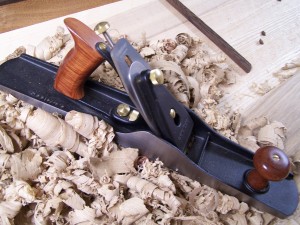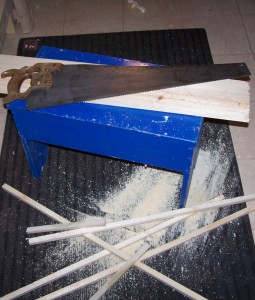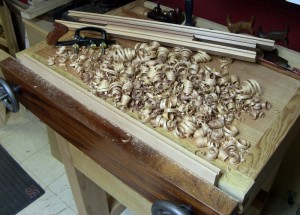Focused Repetition Builds Hand Tool Skills
 Want to improve your hand cut dovetails? Saw plumb and square? Learn to flatten a board by hand? Figure out how to make square rabbets with that skew rabbet plane? Use your tools. Seems simple right? Maybe not.
Want to improve your hand cut dovetails? Saw plumb and square? Learn to flatten a board by hand? Figure out how to make square rabbets with that skew rabbet plane? Use your tools. Seems simple right? Maybe not.
Repetition is key to honing technique but is it really repetition when hours or days pass in between iterations? This is the problem with the “go build furniture to get better” school of thought. For the modern hobbyist woodworker who is lucky to get 5 hours a week in the shop, it may take months to complete a piece of furniture. Fear of ruining a project or screwing up that valuable (and limited) piece of lumber can really hold us back. Moreover the specific skill you are looking to improve may only comprise 5% of the total build. So you screw your courage to the sticking point and cut that dovetail or plow that rabbet. You may blow it completely or with glacial meticulousness, produce a flawless joint. You come out the other side either discouraged or elated. Yes you can learn something by fixing a mistake but have you really improved your ability with this specific task? Maybe, but now it is on to the rest of the project with huge gulfs of time to cross before being confronted with this task again. When that day comes, you are probably right back where you started. I contend that closely spaced repetition of specific tasks will increase your skill much more rapidly and in the end, a surprisingly short amount of time.
 Having trouble sawing to a line? Yes you can put highly detailed and accurate layout lines on your board and focus with every fiber of your being to get the cut started plumb and square then give in to the mantra “let the saw do the work”. Or you can put 10 pencil marks along the length of the board and just cut them in quick succession. Pay attention to each cut and where the deviations occur then make slight adjustments and cut again, then again, and again and again. Making 10 rip cuts in a 24″ long board won’t take more than a few minutes, and it is good exercise. Your body will learn very quickly how to position itself for the best results and most efficient sawing. Soon you will see that those meticulous lay out lines may not be as necessary, nor are those chiseled V grooves used to guide your saw. Sawing is a simple task and can be mastered pretty quickly when all you do is saw. The typical project may only require half the number of rips cuts you just made in 2 minutes, but instead you make those cuts over the course of a week or a month.
Having trouble sawing to a line? Yes you can put highly detailed and accurate layout lines on your board and focus with every fiber of your being to get the cut started plumb and square then give in to the mantra “let the saw do the work”. Or you can put 10 pencil marks along the length of the board and just cut them in quick succession. Pay attention to each cut and where the deviations occur then make slight adjustments and cut again, then again, and again and again. Making 10 rip cuts in a 24″ long board won’t take more than a few minutes, and it is good exercise. Your body will learn very quickly how to position itself for the best results and most efficient sawing. Soon you will see that those meticulous lay out lines may not be as necessary, nor are those chiseled V grooves used to guide your saw. Sawing is a simple task and can be mastered pretty quickly when all you do is saw. The typical project may only require half the number of rips cuts you just made in 2 minutes, but instead you make those cuts over the course of a week or a month.
More complex tasks like cutting joints may require breaking down into simple steps. Don’t worry about fitting the mortise and tenon together just yet, but rather chop 10 mortises all at once. Your technique will improve but so will your efficiency. You will start to recognize just how big a bite the chisel can take and when to lever our chips to balance between clearing the space and providing leverage for the chisel. The mortises and your technique will “mature” from one to the next until things just click into the place and you hear music. Suddenly both your hands are efficiently working in concert to precisely position the chisel between your layout lines. Each mallet blow is rhythmic and provides the optimal balance of depth of cut and levering action. Your mortise goes from 40 mallet strikes down to 15. All in the space of 10 mortises cut one after the other.
So should we all just stop building furniture and only work on abstract practice pieces? Not at all. It might be a good idea when first getting started but I think you can also group all the like actions together on a piece of furniture. Imagine building a Stickley design and just how many mortises make up one of those slatted rails. Lump all 4 rails on a Morris chair together and you will easily find 20 mortises that need to be cut for just those 2 parts. Likewise a typical table will require at least 8 mortises at the apron. Rather than cutting and fitting each mortise and tenon, cutting all the mortises in one session will make a huge difference to your skill set. Obviously there are times when grouping tasks like this won’t work but it is a tip the hand tool woodworker can take from the power tool guys. Once you have set up to do a specific task, why not batch out everything at the same time. You might be surprised at the effect it will have on your muscle memory.
 Finally while so much of this ramble has been focused on those of us trying to learn a skill, the more advanced among us can benefit as well. Great efficiency and refinement of movement can be learned by working this way. Think of the piece workers of the 18th century who did nothing but the same task over and over again all day every day. Each movement is choreographed for optimum result and speed. If I drop my left pinky an inch, increase my speed yet shorten my stroke with the plow plane I can work backward and plow a groove in 1/4 the time while keeping my feet planted and eliminating extraneous movement. While I have plowed hundreds of grooves with a plane, it wasn’t until I did 10 of them back to back that these tiny alterations became obvious.
Finally while so much of this ramble has been focused on those of us trying to learn a skill, the more advanced among us can benefit as well. Great efficiency and refinement of movement can be learned by working this way. Think of the piece workers of the 18th century who did nothing but the same task over and over again all day every day. Each movement is choreographed for optimum result and speed. If I drop my left pinky an inch, increase my speed yet shorten my stroke with the plow plane I can work backward and plow a groove in 1/4 the time while keeping my feet planted and eliminating extraneous movement. While I have plowed hundreds of grooves with a plane, it wasn’t until I did 10 of them back to back that these tiny alterations became obvious.
Let’s call this repetition of a different kind. Happy skill building!


